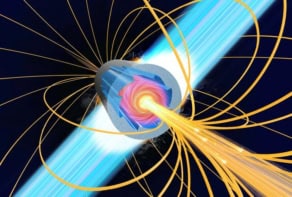Physicists in Switzerland and China have worked out a way – at least in theory – to split a beam of molecules according to their chirality. The technique involves passing the molecules through three different laser beams and is similar to the famous Stern-Gerlach effect, whereby a beam of atoms passing through a magnetic field is split in two according to the atoms’ spin states (Phys. Rev. Lett. 99 130403).
Chiral molecules exist in one of two structures that are mirror images of one another, usually described as “right-handed” and “left-handed” enantiomers. Chirality can be very important in medicine because a right-handed drug molecule may have the desired biological effect while the left handed molecule does not, for example. As a result, a great deal of effort has gone into developing ways to sort molecules according to their chirality.
An important feature of chiral molecules is that they can respond differently when exposed to light. Now Christoph Bruder and Yong Li at the University of Basel along with Chang-Pu Sun of the Chinese Academy of Sciences have worked out how to separate enantiomers using the “Rabi transitions” that can happen when a molecule is exposed to laser light. Such transitions occur when a laser beam causes a molecule to oscillate between two energy levels at a frequency corresponding to that of the laser light.
Their technique involves a chiral molecule with three possible Rabi transitions at three different laser frequencies. Two of the transitions would have to be identical for left- and right-handed molecules, but the third would have a phase difference of 180 degrees between the oscillations that occur in the two enantiomers.
According to the team’s calculations, if these molecules were all oriented in a similar way and then sent directly into the three laser beams, the phase difference would cause right-handed molecules to be deflected off course more than left-handed molecules. Moreover, the direction of deflection would depend on which of the two spin states — up or down — the molecules are in. The upshot is that the molecules would be sorted into four groups according to chirality and spin: right-up, right-down, left-up and left-down.
While some molecules could have appropriate three-level systems, Bruder told physicsworld.com that the experiment would be challenging for several reasons. For one thing, it would require three lasers operating at three very specific frequencies. Also, the molecules would have to be very cold for the effect to be noticeable and the molecules would have to be oriented beforehand in a specific way.
Although these difficulties mean that the technique will probably not lead to a practical way of separating real molecules, Bruder is hopeful that experimental physicists will work out a way to confirm the team’s calculations.


